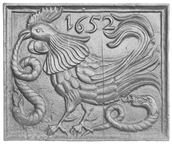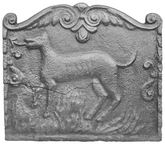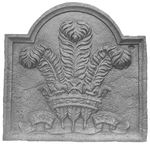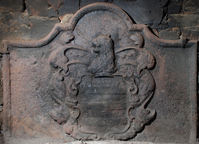-
120
Description: Rectangular; rope edge (top and sides); rose and crown within a shield, stamped twice, both inverted, down centre; rectangular stamp with griffin, twice, in top corners.
Notes: Five other firebacks bearing these stamps are known: one is also in Hastings, and one, dated 1569, is at Hadlow Down, Sussex. The locations of the other three are not known. Formerly part of the Ade Collection (from Grove Hill, Hellingly, Sussex).
- Decoration tags:
- rectangular (shape)
- rope (edging)
- carved stamps
- heraldic
Manufactured: in the mid- to late-16th century in the Weald area of England.
Current location: Hastings Museum and Art Gallery, John's Place, Bohemia Road, Hastings, East Sussex, England.
Museum number: HASMG: 1952.51.11 (part of the Hastings Museum museum group)
Citation: Baines, J. M., 1958, Wealden Firebacks (Hastings Museum).
- Attached to series:
- Griffin series
-
651
Description: Rectangular; cavetto edging; a left-facing cockerel grasps a snake in its beak, another snake writhes on the ground behind it; date to left of the cockerel’s tail; four vertical planklines.
Notes: The design may have religious significance, the snake symbolising sin and the cockerel denoting St Peter’s denial of Christ. The ‘1’ of the date is hooked, suggesting a common source with firebacks designed by the pattern-maker, IM. A copy of this fireback is set into the brickwork of 16 Old Church Street, Chelsea, London.
Copies of this fireback are known.
Inscription: 1652
- Decoration tags:
- rectangular (shape)
- cavetto (edging)
- whole carved pattern
- planklines
- pictorial
- biblical
- text
- animals
Manufactured: in 1652 possibly at Brede Furnace in the Weald area of England.
Current location: not known.
- Attached to series:
- Small cavetto series
- Hooked '1' series
- New Testament firebacks
- Brede group
-
850
Description: Canted rectangle; elaborate cavetto moulded edging (top and sides); strapwork shield with a demi-flower at each side, between initials (S only visible); arms quarterly of six, 1st Or two chevronels Gules, on a canton of the last a mullet of the first (Pope); 2nd Argent three bars Gules, on a canton ermine a bend of lozenges of the second (Walshe); 3rd Sable three laurel leaves in bend Or between two bendlets Argent (Waller); 4th Azure a chevron between three crosses Moline Argent (Lansdale); 5th Ermine on a bend Gules three lions’ heads erased Or (Weston); 6th Azure a lion rampant Or supporting a cross patée fitchée of the second (Pichingham).
Notes: The excrescence over the third quartering is the result of the iron being poured directly onto the mould. The second initial is known from another casting. The date above the shield has been inserted before casting and differs slightly from another example of the same back.
Copies of this fireback are known.
Inscription: 1625 / S [P]
Arms: Pope (Sackevile Pope (b. 1589) of Hendall, in Buxted, Sussex)
- Decoration tags:
- rectangular with canted top corners (shape)
- complex individual (edging)
- whole carved pattern
- date stamp
- armorial
- text
Manufactured: in 1625 in the Weald area of England.
Current location: not known.
- Attached to series:
- Personal armorial firebacks
- Low relief armorial series
-
851
Description: Rectangular with mirrored floriate scrolled top; simulated overlapping tile edging at sides, with fillet bottom edge; a mythical salamander in the form of a dog with an arrow-shaped tongue, standing among flames; a stapled scroll inside the left and right edges.
Notes: This fireback was used to create a composite fireback design on a plate at Rivers Farmhouse, Ardingly (no. 13).
- Decoration tags:
- rectangular (shape)
- simulated overlapping tile (edging)
- whole carved pattern
- mythological
- animals
- objects
Manufactured: in the mid-17th century in the Weald area of England.
Current location: not known.
Citation: Lloyd, N., 1925, 'Domestic Ironwork I', Architectural Review, 58, pp. 58-67.
- Attached to series:
- Stapled scroll series
- Brede group
-
852
Description: Rectangular; cyma recta (ogee) moulded edging (top and sides); fleur-de-lys stamp repeated three times across the upper part of the plate; a long pastry mould stamped between each pair of fleurs; above the central fleur, a small stamp, over-pressed, bearing FL below a coronet; above the right fleur, a small stamp, over-pressed, bearing a fish embowed.
Notes: The food moulds are variations of others used in the same series.
Inscription: FL
- Decoration tags:
- rectangular (shape)
- cyma reversa/ogee (edging)
- simple stamps
- carved stamps
- heraldic
- text
- animals
- objects
Manufactured: in the mid- to late-16th century possibly at Pounsley Furnace, Framfield in the Weald area of England.
Current location: not known.
- Attached to series:
- Food mould stamp firebacks
- Pounsley series
- Fleur-de-lys firebacks
-
853
Description: Arched rectangular shape; cavetto edging; three ostrich feathers issuing from a royal coronet; motto banner below.
Notes: The badge of the Prince of Wales; perhaps cast during the Commonwealth period; a copy at Rottingdean Grange (no. 670) has added initials.
Copies of this fireback are known.
Inscription: ICH [DIEN]
- Decoration tags:
- rectangular with round arch (shape)
- cavetto (edging)
- whole carved pattern
- heraldic
- royal
- text
- objects
Manufactured: in the mid-17th century in the Weald area of England.
Current location: not known.
Citation: Lloyd, N., 1925, 'Domestic Ironwork I', Architectural Review, 58, pp. 58-67.
- Attached to series:
- Prince of Wales firebacks
-
149
Description: Arched rectangular shape; ovolo moulded edging; date in arch; below arch two parallel, vertical straps, each with a buckle at the top; initials left and right of centre; rectangular stamp with bird, four times across top; larger rectangular stamp with unidentified animal, twice below initials.
Notes: The buckles suggest a connection with the Pelham family; the initials may relate to Sir Thomas Pelham, Bt. (1597-1654) who owned and operated ironworks at Waldron in Sussex. This is one of a few examples of a copy of a casting of the original pattern to which additional stamps had been added. Formerly part of the Ade Collection (from Grove Hill, Hellingly, Sussex).
Inscription: 1642 / T P
- Decoration tags:
- rectangular with round arch (shape)
- ovolo (edging)
- simple stamps
- carved stamps
- whole carved pattern
- individual numbers
- planklines
- text
- objects
Manufactured: in the mid-17th century possibly at Waldron Furnace in the Weald area of England.
Current location: Hastings Museum and Art Gallery, John's Place, Bohemia Road, Hastings, East Sussex, England.
Museum number: HASMG: 1952.51.61 (part of the Hastings Museum museum group)
- Attached to series:
- 1642 Pelham series
- Pelham family firebacks
-
399
Description: Arched rectangular shape; ovolo-moulded edging with inverted fleur-de-lys at top; lion passant guardant, with rose to the left and thistle above tail; date split between legs; single horizontal plank-line.
Notes: The boldness of the figuration suggests association with firebacks possibly cast at Brede Furnace in the same period.
Copies of this fireback are known.
Inscription: 1 6 5 6
- Decoration tags:
- rectangular with round arch (shape)
- cyma reversa/ogee (edging)
- whole carved pattern
- planklines
- heraldic
- text
- animals
- plants
Manufactured: in 1656 in the Weald area of England.
Current location: not known.
- Attached to series:
- Royalist series
-
812
 ? x ? mm
? x ? mmDescription: Canted rectangle; twisted rope edging (top and sides); divided by rope lengths into four panels: centre top, square; centre bottom, trapezium; sides, irregular hexagons; buckle stamp repeated three times, in bottom and side panels; top centre panel, circular flower stamp with fleur de lys on each petal.
Notes: The buckle stamps suggest a connection with the Pelham family; illustrated in Butterfield 1916, where it was stated to have been in a house at Herstmonceux, Sussex..
- Decoration tags:
- rectangular with canted top corners (shape)
- rope (edging)
- simple stamps
- carved stamps
- planklines
- heraldic
- objects
Manufactured: in the late-16th century in the Weald area of England.
Current location: not known.
Citation: Butterfield, W. R., 1916, 'Old Wealden Firebacks', The Connoisseur, 46, pp. 197-209.
- Attached to series:
- Pelham family firebacks
- Metalware stamp firebacks
-
913
Description: Rectangular with an arched rectangular style arch linked by symmetrical concave curves; ovolo moulding (top and sides); shield, helm, crest and mantling of the Fuller family. A number 7, the only visible part of the date seen on other castings is in the top right corner of the shield.
Notes: A carved armorial on a plain, edged base board; the arms of the Fullers of Brightling Park, Sussex: Argent, three bars and a canton gules; the crest; Out of a ducal coronet Or, a lion’s head argent; the Fullers were iron masters and gun founders in the first half of the 18th century, operating Heathfield furnace, where it is likely that this fireback was cast.
Inscription: [1] 7 / [4] [7]
Arms: Fuller, of Brightling, Sussex
- Decoration tags:
- rectangular with round arch (shape)
- ovolo (edging)
- carved pattern panels
- armorial
Manufactured: in 1747 probably at Heathfield Furnace in the Weald area of England.
Current location: in private hands, Brightling, East Sussex, England.
- Attached to series:
- Ironmasters armorial series
- Personal armorial firebacks
.jpg)





.jpg)

